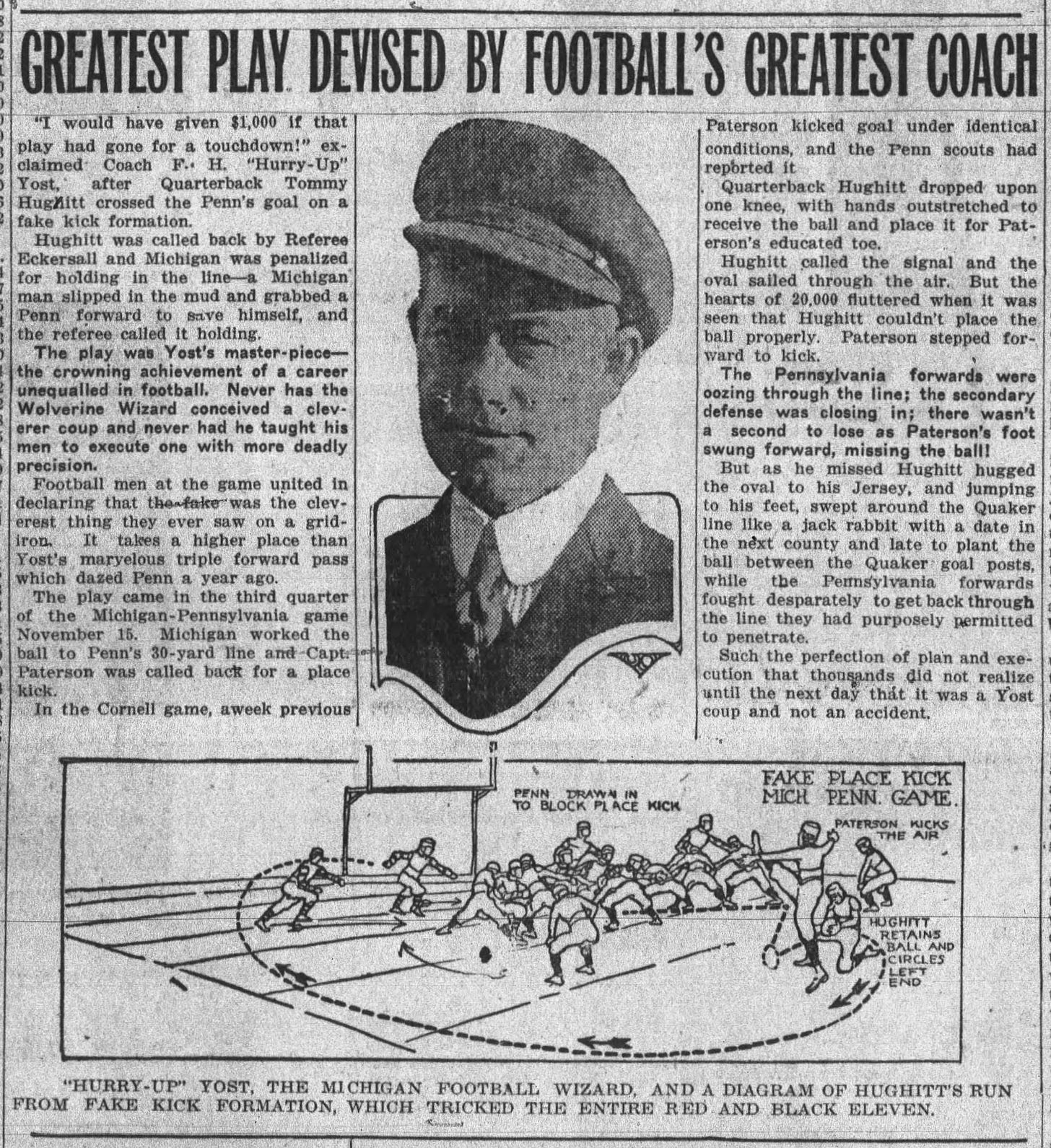Fielding Yost and the First Fake Field Goal
There is nothing new under football's sun. Many plays, techniques, and concepts are borrowed, recycled, adapted, or reinvented by those unaware someone else already rolled out that invention. Still, everything borrowed or recycled had a beginning, a first use, so the trick is to identify when an idea hatched.
Finding the hatching point is made more difficult by those who mistake the first time they see something with the first time anyone saw that something. That was the case in 1913 when a writer credited Michigan coach Fielding H. "Hurry Up" Yost with devising the fake field goal when the Wolverines ran it against Penn. In the weeks following the game, an anonymously-written article appeared in newspapers across the country extolling Yost's brilliance in designing and calling the play.
As the article describes, Michigan lined up to attempt a field goal with their quarterback on one knee and his hands outstretched to receive the ball from the center while the kicker lined up behind him. At the snap, the kicker moved forward and swung his leg as if to kick the ball, but the quarterback never placed the ball on the ground. Instead, he jumped up and ran the ball around the left end for the score.
The writer was rather impressed with Yost's creative play:
The play was Yost's masterpiece - the crowning achievement of a career unequaled in football. Never has the Wolverine Wizard conceived a cleverer coup and never had he taught his men to execute one with more deadly precision.
Of course, there are several things wrong here. First, the Wolverines did not execute the fake kick with deadly precision since Michigan incurred a holding penalty on the play. And while there is no doubt that Yost was among the top coaches of his day, he did not invent the fake field goal play, and as it turns out, the 1913 Penn game was not the first time his teams used the play. So, let's take a second look at the origins of the fake field goal play.
Before getting into the origins of fake field goals, we need to review field goal kicking back in the day. Until 1896, all attempts to kick a "goal from field" aka a field goal, occurred by drop kick because the place kick from scrimmage was not yet invented. Recall that the football snap initially happened using the feet, as in a rugby scrum. Snapping with the hands was not the norm until around 1890. Even then, centers rolled the ball back on its side, after which the quarterback picked it up and tossed it to a fullback or halfback who ran, punted, or dropkicked. Long snapping took a couple more years to come along.
In addition, the "goal from touchdown," now called the extra point, was a free kick, typically executed from placement. The placer, now called a holder, laid on his stomach or side, placed the ball to the ground, and held it for the kicker. As a free kick, there was no rush and no hurry.

Of course, fake extra-point attempts did not make sense at the time since teams scored on these plays only by kicking the goal. Not until 1922 did teams attempt the extra point from scrimmage, with the scoring team having the choice to kick, run, or pass from the five-yard line. Each scored one point when successful.
Things changed in 1896 when a pair of brothers from Otterbein wrote to Walter Camp to confirm the legality of their idea to placekick from scrimmage, given that placekicks flew farther and were more accurate than drop kicks, plus they worked in any weather. (Dropkicks did not bounce off the ground well on muddy fields.) The Otterbeiners' idea was to have the center snap the ball to a placer, who held the ball on the ground for the kicker. Once Camp confirmed its legality, they implemented the approach, which spread like wildfire once Princeton borrowed it, leading the tactic to become known as the Princeton placekick.

Having established that the placekicked goal from field arrived in 1896 and became popular in 1897, in what year would you expect the first fake placekicked field goal to occur? Was it in 1913 at the Michigan-Penn game? Definitely not. The first documented fake field goal attempt came in 1897 when Kansas executed one versus Iowa. What about the second fake field goal attempt? As it turns out, the second documented fake came in the 1898 Kansas-Nebraska game while Kansas was on defense. That means the Bugeaters of Nebraska executed the second fake kick while being led by their first-year head coach, Fielding Yost.

Not only did those fake field goals precede the 1913 attempt by Michigan, but so did dozens more by the likes of Wisconsin, Kansas Normal, Oberlin, Colorado State, Georgia Tech, Drake, Holy Cross, Delaware, Georgia Tech, and get this, Michigan. The Wolverines, coached by the Fielding H. Yost, lost 15 yards on a fake field goal when playing Chicago in 1902.
In the end, Yost did not invent the play but was an early adopter, and his teams used it at least twice before the 1913 game in which he purportedly invented it. In fact, the fake placekicked field goal arrived shortly after the placekicked field goal itself and was in common use when the intrepid reporter first saw it in 1913.
Football Archaeology is reader-supported. Click here to buy one of my books or otherwise support the site.



